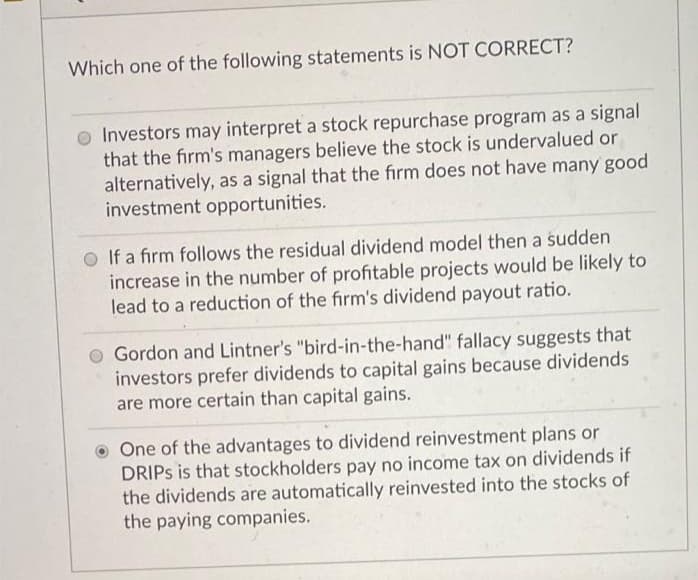Which one of the following statements is NOT CORRECT? o Investors may interpret a stock repurchase program as a signal that the firm's managers believe the stock is undervalued or alternatively, as a signal that the firm does not have many good investment opportunities. O If a firm follows the residual dividend model then a sudden increase in the number of profitable projects would be likely to lead to a reduction of the firm's dividend payout ratio. Gordon and Lintner's "bird-in-the-hand" fallacy suggests that investors prefer dividends to capital gains because dividends are more certain than capital gains. O One of the advantages to dividend reinvestment plans or DRIPS is that stockholders pay no income tax on dividends if the dividends are automatically reinvested into the stocks of the paying companies.
Which one of the following statements is NOT CORRECT? o Investors may interpret a stock repurchase program as a signal that the firm's managers believe the stock is undervalued or alternatively, as a signal that the firm does not have many good investment opportunities. O If a firm follows the residual dividend model then a sudden increase in the number of profitable projects would be likely to lead to a reduction of the firm's dividend payout ratio. Gordon and Lintner's "bird-in-the-hand" fallacy suggests that investors prefer dividends to capital gains because dividends are more certain than capital gains. O One of the advantages to dividend reinvestment plans or DRIPS is that stockholders pay no income tax on dividends if the dividends are automatically reinvested into the stocks of the paying companies.
Financial Reporting, Financial Statement Analysis and Valuation
8th Edition
ISBN:9781285190907
Author:James M. Wahlen, Stephen P. Baginski, Mark Bradshaw
Publisher:James M. Wahlen, Stephen P. Baginski, Mark Bradshaw
Chapter5: Risk Analysis
Section: Chapter Questions
Problem 2QE
Related questions
Question

Transcribed Image Text:Which one of the following statements is NOT CORRECT?
o Investors may interpret a stock repurchase program as a signal
that the firm's managers believe the stock is undervalued or
alternatively, as a signal that the firm does not have many good
investment opportunities.
O If a firm follows the residual dividend model then a sudden
increase in the number of profitable projects would be likely to
lead to a reduction of the firm's dividend payout ratio.
Gordon and Lintner's "bird-in-the-hand" fallacy suggests that
investors prefer dividends to capital gains because dividends
are more certain than capital gains.
O One of the advantages to dividend reinvestment plans or
DRIPS is that stockholders pay no income tax on dividends if
the dividends are automatically reinvested into the stocks of
the paying companies.
Expert Solution
This question has been solved!
Explore an expertly crafted, step-by-step solution for a thorough understanding of key concepts.
This is a popular solution!
Trending now
This is a popular solution!
Step by step
Solved in 2 steps

Knowledge Booster
Learn more about
Need a deep-dive on the concept behind this application? Look no further. Learn more about this topic, finance and related others by exploring similar questions and additional content below.Recommended textbooks for you

Financial Reporting, Financial Statement Analysis…
Finance
ISBN:
9781285190907
Author:
James M. Wahlen, Stephen P. Baginski, Mark Bradshaw
Publisher:
Cengage Learning


EBK CONTEMPORARY FINANCIAL MANAGEMENT
Finance
ISBN:
9781337514835
Author:
MOYER
Publisher:
CENGAGE LEARNING - CONSIGNMENT

Financial Reporting, Financial Statement Analysis…
Finance
ISBN:
9781285190907
Author:
James M. Wahlen, Stephen P. Baginski, Mark Bradshaw
Publisher:
Cengage Learning


EBK CONTEMPORARY FINANCIAL MANAGEMENT
Finance
ISBN:
9781337514835
Author:
MOYER
Publisher:
CENGAGE LEARNING - CONSIGNMENT

Intermediate Financial Management (MindTap Course…
Finance
ISBN:
9781337395083
Author:
Eugene F. Brigham, Phillip R. Daves
Publisher:
Cengage Learning

Auditing: A Risk Based-Approach (MindTap Course L…
Accounting
ISBN:
9781337619455
Author:
Karla M Johnstone, Audrey A. Gramling, Larry E. Rittenberg
Publisher:
Cengage Learning